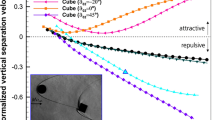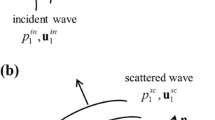Abstract
Background
Because of technical limitations, most experimental studies on the energy-absorbing properties of ballistic fabrics are limited to discrete evaluations based on impact and residual velocities. Consequently, the continuous interaction between a projectile and a target material is still commonly assessed with analytical models or numerical simulations, the validation of which is based on the aforementioned discrete values.
Objective
The present document aims at describing and validating a new experimental method to make it possible to evaluate the continuous evolution of the projectile velocity during penetration into a fabric material. The method is based on the Doppler effect and a specific and complex nonstationary signal treatment.
Methods
A high-frequency continuous-wave Doppler radar was adapted to assess the continuous evolution of the velocity of a projectile penetrating a fabric material. Based on two ballistic-grade fabric configurations, a perforating and a nonperforating case were described and evaluated. The instantaneous Doppler frequency was extracted based on the Hilbert-Huang transform. A validation of the proposed method was performed based on high-speed camera images, giving the displacement of the apex of the deformation pyramid of the fabric with time. Additionally, a Weibel® Doppler radar was used to measure the impact velocity.
Results
Based on instantaneous frequencies deduced from the high-frequency radar signal analysis, Doppler theory and high-speed camera images, velocity–time and displacement–time plots were obtained. Additionally, the evolution of the fabric deformation (pyramid morphology) was recorded from the high-speed camera images.
Conclusions
Comparisons between the data assessed with the high-frequency Doppler radar and those deduced from the high-speed camera indicated that good agreement exists between the two methods. The new Doppler radar method seems to be a promising complementary tool for measuring the continuous interaction between a projectile and a fabric target material.













Similar content being viewed by others
References
Wambua P, Vangrimde B, Lomov S, Verpoest I (2007) The response of natural fibre composites to ballistic impact by fragment simulating projectiles. Compos Struct 77:232–240. https://doi.org/10.1016/j.compstruct.2005.07.006
Larsson F, Svensson L (2002) Carbon, polyethylene and PBO hybrid fibre composites for structural lightweight armour. Compos Part A 33:221–231. https://doi.org/10.1016/S1359-835X(01)00095-1
Cunniff PM (1992) An analysis of the system effects in woven fabrics under ballistic impact. Text Res J 62:495–509. https://doi.org/10.1177/004051759206200902
Flanagan MP, Zikry MA, Wall JW, El-Shiekh E (1999) An experimental investigation of high velocity impact and penetration failure modes in textile composites. J Compos Mater 33:1080–1103. https://doi.org/10.1177/002199839903301202
Içten BM, Karakuzu R (2008) Effects of weaving density and curing pressure on impact behaviour of woven composite plates. J Reinf Plast Comp 27:1083–1092. https://doi.org/10.1177/0731684407087080
Lim CT, Tan VBC, Cheong CH (2002) Perforation of high-strength double-ply fabric system by varying shaped projectiles. Int J Imp Eng 27:577–591. https://doi.org/10.1016/S0734-743X(02)00004-0
Akdemir A, Candan C, Sahin OS (2008) Effects of production parameters and conditioning upon ballistic characteristics of para aramid light armors. J Compos Mater 42:2051–2061. https://doi.org/10.1177/0021998308094545
Wilde AF, Roylance DK, Rogers JM (1973) Photographic investigation of high-speed missile impact upon nylon fabric. Part I: energy absorption and cone radial velocity in fabric. Text Res J 43:753–761. https://doi.org/10.1177/004051757304301212
Tan VBC, Lim CT, Cheong CH (2003) Perforation of high-strength fabric by projectiles of different geometry. Int J Imp Eng 28:207–222. https://doi.org/10.1016/S0734-743X(02)00055-6
Gower HL, Cronin DS, Plumtree A (2008) Ballistic impact response of laminated composite panels. Int J Imp Eng 35:1000–1008. https://doi.org/10.1016/j.ijimpeng.2007.07.007
Montgomery TG, Grady PL, Tomasino C (1982) The effects of projectile geometry on the performance of ballistic fabrics. Text Res J 52:442–450. https://doi.org/10.1177/004051758205200703
Cunniff PM (1996) A semiempirical model for the ballistic impact performance of textile-based personnal armor. Text Res J 66:45–59. https://doi.org/10.1177/004051759606600107
Chu CK, Chen YL, Hseu GC, Hwang DG (2007) The study of obliquity on the ballistic performance of basket fabric composite materials. J Compos Mater 41:1539–1558. https://doi.org/10.1177/0021998306068098
Chu TL, Imad A, Ha-Minh C (2016) A numerical investigation of the influence of yarn mechanical and physical properties on the ballistic impact behavior of a Kevlar KM2® woven fabric. Compos Part B 95:144–154. https://doi.org/10.1016/j.compositesb.2016.03.018
Ha-Minh C, Imad A, Kanit T, Boussu F (2013) Numerical analysis of a ballistic impact on textile fabric. Int J Mech Sci 69:32–39. https://doi.org/10.1016/j.ijmecsci.2013.01.014
Ha-Minh C, Boussu F, Kanit T, Crepin D, Imad A (2011) Analysis on failure mechanisms of an interlock woven fabric under ballistic impact. Eng Fail Anal 18:2179–2187. https://doi.org/10.1016/j.engfailanal.2011.07.011
Chu TL, Ha-Minh C, Imad A (2017) Analysis of local and global localizations on the failure phenomenon of 3D interlock woven fabrics under ballistic impact. Compos Struct 159:267–277. https://doi.org/10.1016/j.compstruct.2016.09.039
Shockey DA, Erlich DC, Simons JW (1999) Lightweight fragment barriers for commercial aircraft. Proceedings of the 18th International Symposium on Ballistics, pp 1192–1199
Cork CR (2005) The effect of boundary conditions on the ballistic performance of textile fabrics. Proceedings of the 22nd International Symposium on Ballistics, pp 1008–1015
Novotny WR, Cepuš E, Shahkarami A, Vaziri R, Poursartip A (2007) Numerical investigation of the ballistic efficiency of multi-ply fabric armours during the early stages of impact. Int J Imp Eng 34:71–88. https://doi.org/10.1016/j.ijimpeng.2006.07.001
Duan Y, Keefe M, Bogetti TA, Cheeseman BA, Powers B (2006) A numerical investigation of the influence of friction on energy absorption by a high-strength fabric subjected to ballistic impact. Int J Imp Eng 32:1299–1312. https://doi.org/10.1016/j.ijimpeng.2004.11.005
Phoenix SL, Porwal PK (2003) A new membrane model for the ballistic impact response and V50 performance of multi-ply fibrous systems. Int J Solids Struct 40:6723–6765. https://doi.org/10.1016/S0020-7683(03)00329-9
Naik NK, Shrirao P (2004) Composite structures under ballistic impact. Compos Struct 66:579–590. https://doi.org/10.1016/j.compstruct.2004.05.006
Taylor WJ Jr, Vinson JR (1990) Modeling ballistic impact into flexible materials. AIAA J 28:2098–2103. https://doi.org/10.2514/3.10527
Billon HH, Robinson DJ (2001) Models for the ballistic impact of fabric armour. Int J Imp Eng 25:411–422. https://doi.org/10.1016/S0734-743X(00)00049-X
Anderson CE Jr, Chocron S (2009) Experimental results and a simple theory for the early deflection-time history of a ballistic fabric. 16th APS Topical Conference on Shock Compression of Condensed Matter. https://doi.org/10.1063/1.3295086
Starratt D, Sanders T, Cepuš E, Poursartip A, Vaziri R (2000) An efficient method for continuous measurement of projectile motion in ballistic impact experiments. Int J Imp Eng 24:155–170. https://doi.org/10.1016/S0734-743X(99)00045-7
Chocron S, Samant KR, Nicholls AE, Figueroa E, Weiss CE, Walker JD, Anderson CE Jr (2009) Measurement of strain in fabrics under ballistic impact using embedded nichrome wires. Part I: technique. Int J Imp Eng 36:1296–1302. https://doi.org/10.1016/j.ijimpeng.2009.04.004
Goldman DI, Umbanhowar P (2008) Scaling and dynamics of sphere and disk impact into granular media. Phys Rev E 77:021308. https://doi.org/10.1103/PhysRevE.77.021308
Scott BR, Dehmer P, Schmidt T (2005) Time resolved observation of the deformation and surface strain of a textile fabric subject to ballistic impact. Proceedings of the 22nd International Symposium on Ballistics, pp 743–751
Vandeveld T, Van Roey J, Delcourt E (2010) Assessment of flexible armour ballistic performance by stereoscopic displacement and stress measurement. Proceedings of the Personal Armour Systems Symposium (PASS 2010)
Van Roey J (2011) Etude du comportement dynamique des matériaux granulaires et tissés: approche expérimentale et simulation numérique. PhD thesis, Royal Military Academy & Université de Lille 1 Sciences et Technologies
Qian S, Chen D (1996) Joint-time frequency analysis. Prentice-Hall PTR, New Jersey
Huang NE, Wu Z, Long SR, Arnold KC, Chen X, Blank K (2009) On instantaneous frequency. Adv Adapt Data Anal 1:177–229. https://doi.org/10.1142/S1793536909000096
Huang NE, Shen Z, Long SR, Wu MC, Shih HH, Zheng W, Yen NC, Tung CC, Liu HH (1998) The empirical mode decomposition and the Hilbert spectrum for nonlinear and non-stationary time series analysis. Proc R Soc London A 454:903–995. https://doi.org/10.1098/rspa.1998.0193
Huang NE, Shen SSP (2005) Hilbert-Huang transform and its applications. World Scientific Publishing, Singapore
Nunes JC, Deléchelle E (2009) Empirical mode decomposition: Applications on signal and image processing. Adv Adapt Data Anal 1:125–175. https://doi.org/10.1142/S1793536909000059
Wu Z, Huang NE (2009) Ensemble empirical mode decomposition: a noise-assisted data analysis method. Adv Adapt Data Anal 1:1–41. https://doi.org/10.1142/S1793536909000047
Acknowledgments
This research was conducted with the assistance of the Royal Military Academy’s Dynamic Material Behaviour and Security Applications research pole, which provided valuable support for the numerical work carried out in the framework of the aforementioned study. Additionally, we offer a sincere thank you to Mr. Messaoud CHAYANI from Lille University Graduate School of Engineers for his diligent proofreading of this paper.
Author information
Authors and Affiliations
Corresponding author
Rights and permissions
About this article
Cite this article
Gilson, L., Imad, A., Rabet, L. et al. Real-time Measurement of Projectile Velocity in a Ballistic Fabric with a High-frequency Doppler Radar. Exp Mech 61, 533–547 (2021). https://doi.org/10.1007/s11340-020-00676-4
Received:
Accepted:
Published:
Issue Date:
DOI: https://doi.org/10.1007/s11340-020-00676-4




